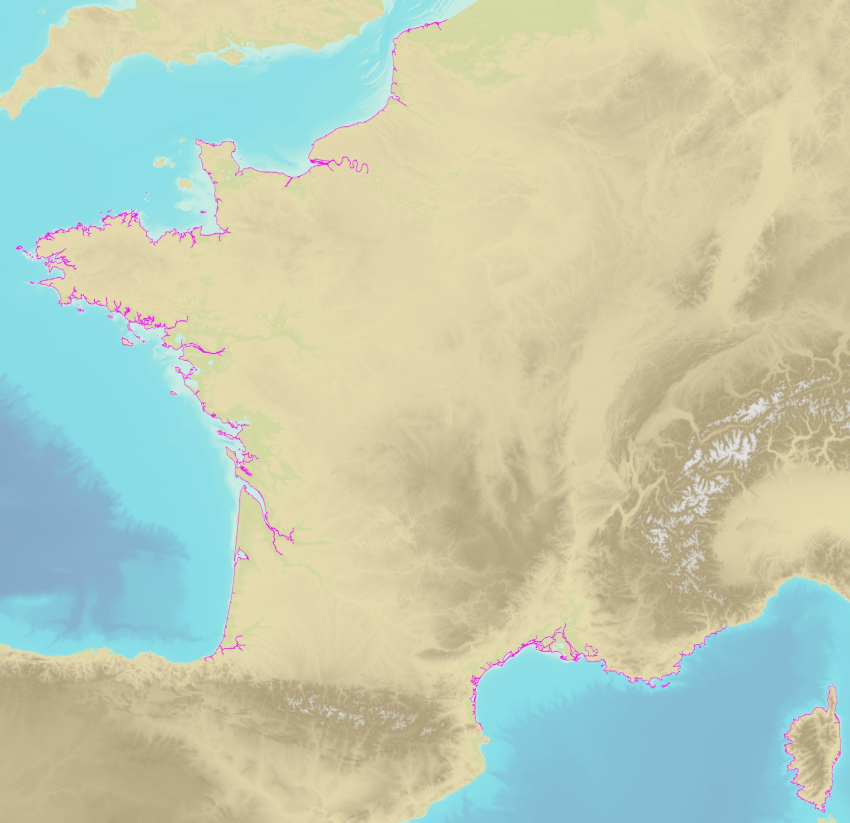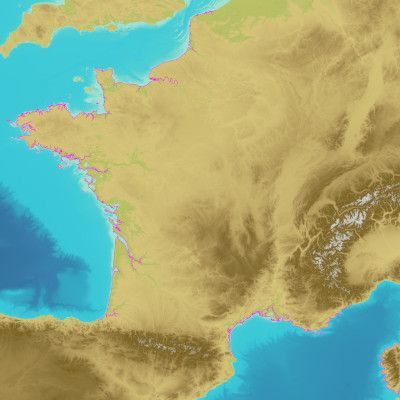2000
Type of resources
Available actions
Topics
Keywords
Provided by
Years
Formats
Representation types
Update frequencies
status
Scale
Resolution
-

The land-sea limit corresponds to the Highest Astronomical Tide (HAT) in the case of a tide of coefficient 120 and under normal meteorological conditions (no offshore wind and mean atmospheric pressure of 1013 hPa). This geometric line is naturally defined as the intersection of a HAT model (extended to the coast and the top end of the upper estuary) based on the available Bathyelli surfaces, and a high-resolution digital terrain model of the coastal area. It corresponds to the highest limit of the intertidal area and takes into account, when they exist, the 3 administrative maritime limits which are: the transversal limit of the sea (LTM), the salt water limit (LSE) and the limit of maritime jurisdiction (LAM). This limit is measured (quoted) in relation to the local hydrographic chart datum and to the levels of reference for France (IGN69 and IGN78 for Corsica). Relations to other levels of reference (mean sea level and ellipsoid) are known. The land-sea limit product, mainly results from the exploitation of the two products Litto3D®/RGEALTI® and Bathyelli, and represents, with a metric resolution (1 to 5 metres), this theoretical entity by a set of 2D polylines describing the nature of the coast (artificial or natural, rocky or sandy, steep or flat, etc.). The method used for calculating the land-sea limit makes it possible to produce a continuous, homogeneous and spatially coherent limit on the entire French metropolitan coastal area.
-

The land-sea limit corresponds to the Highest Astronomical Tide (HAT) in the case of a tide of coefficient 120 and under normal meteorological conditions (no offshore wind and mean atmospheric pressure of 1013 hPa). This geometric line is naturally defined as the intersection of a HAT model (extended to the coast and the top end of the upper estuary) based on the available Bathyelli surfaces, and a high-resolution digital terrain model of the coastal area. It corresponds to the highest limit of the intertidal area and takes into account, when they exist, the 3 administrative maritime limits which are: the transversal limit of the sea (LTM), the salt water limit (LSE) and the limit of maritime jurisdiction (LAM). This limit is measured (quoted) in relation to the local hydrographic chart datum and to the levels of reference for France (IGN69 and IGN78 for Corsica). Relations to other levels of reference (mean sea level and ellipsoid) are known. The land-sea limit product, mainly results from the exploitation of the two products Litto3D®/RGEALTI® and Bathyelli, and represents, with a metric resolution (1 to 5 metres), this theoretical entity by a set of 2D polylines describing the nature of the coast (artificial or natural, rocky or sandy, steep or flat, etc.). The method used for calculating the land-sea limit makes it possible to produce a continuous, homogeneous and spatially coherent limit on the entire French metropolitan coastal area.
-
Ce jeu de données représente les périmètres d'interventions des 4 pôles territoriaux (PT) qui ont été créés le 1er janvier 2016 pour renforcer la territorialisation de Bordeaux Métropole dans le cadre de son projet de Métropolisation (Loi MAPTAM). Guichets pour les usagers et interlocuteurs pour les entrepreneurs, responsables des opérations d'investissement sur les espaces publics (voies et réseaux) ils participent à la conception des projets d'aménagement, formulent des avis sur les autorisations d'occupation du sol, relaient la «politique de la ville», suivent les transports scolaires, veillent sur les espaces publics. Ils ont une relation privilégiée avec les communes de leur périmètre. Un contrat d'engagement entre Bordeaux Métropole et les communes définit le niveau de service attendu pour chaque activité et permet d'organiser l'exercice des activités mutualisées au sein des services communs.
-
Ce jeu de données signale sous forme de ponctuels la présence d'un ouvrage de type château d'eau, réservoir, ou bâche utilisée pour stocker l'eau destinée à la consommation humaine.
-

Dans le cadre de PIGMA, est produit un référentiel aquitain d'occupation du sol à grande échelle par photo-interprétation. Il s'agit d'une description fine du territoire. La production a débutée en 2010 sur la zone pilote du littoral par le GIP Littoral Aquitain pour les millésimes 2000 et 2009. A l'initiative du Conseil Régional d'Aquitaine, ce référentiel fait à présent l'objet d'une extension sur le reste du territoire de la région pour les deux millésimes 2000 et 2009. Cette production bénéficie du soutien financier du Conseil Régional, de l'Europe (FEDER), de l'Etat, et des Conseils Généraux de la Dordogne, de la Gironde, des Landes, du Lot et Garonne, des Pyrénées-Atlantiques et du GIP ATGeRi, ainsi qu'un apport en données et ingénierie de l'IGN. Une nomenclature emboîtée à 4 niveaux et 56 postes a été définie. Elle est basée sur la nomenclature européenne CORINE LAND COVER. Cette nomenclature a été adaptée au territoire aquitain après analyse et remontée des besoins par les partenaires.
-
Rétrodiffusion du fond marin du canyon de Capbreton, dans le golfe de Gascogne (campagne SEDYMAQ3 en 2012), au pas de 1 mètre. Les données ont été acquises par le sondeur multifaisceau EM2040 du N/O Thalia. Description de la campagne : GILLET Hervé (2012) SEDYMAQ3 cruise, RV Thalia, https://doi.org/10.17600/12070080
-

Fond de plan constitué, complété et mis en forme par les membres du GIP ATGeRi notamment les Services Départementaux d'Incendie et de Secours Aquitain et des structures de Défenses des Forêts contre l'Incendie sur l'Aquitaine. Référentiel métier grande échelle constitué sur ossature Bd Topo et mise à jour et enrichi par les membres du GIP. Date de Publication : 2010
-
Ce jeu de données représente sous forme d'objets linéaires les éléments électriques (armoires, chambres, câbles) liés aux ouvrages d'assainissement (station de pompage, bassin, etc.) Il est associé au jeu de données "A_TEXT_P" qui affiche à l'écran la valeur de l'attribut « type ».
-

Réalisation de la photo-interprétation assistée par ordinateur (PIAO) de l'occupation du sol du territoire du littoral Aquitain couvrant 9 SCOT. Le SCOT de Bayonne fait l'objet d'une interprétation plus fine. Une nomenclature repondant aux exigences européennnes et nationale Une nomenclature emboitée à 4 niveaux et 56 postes a été définie. Elle est basée sur la nomenclature européenne CORINE LAND COVER. Cette nomenclature a été adaptée au territoire aquitain après analyse et remontée des besoins par les partenaires.
-

Points d'Apport du Verre, sur le territoire de la Communauté de communes de Montesquieu, localisés à l'échelle cadastre DGFIP
 Catalogue PIGMA
Catalogue PIGMA